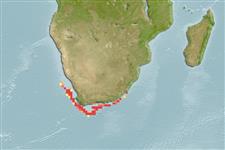Common names from other countries
Пластиножаберные (акулы и скаты) (sharks and rays) >
Rajiformes (Skates and rays) >
Rajidae (Skates)
Etymology: Neoraja: Greek, neos = new + Latin, raja = fish, Raja sp. (Ref. 45335).
Environment: milieu / climate zone / depth range / distribution range
экология
морской батидемерсальный; пределы глубины 102 - 1025 m (Ref. 5578). Deep-water; 29°S - 40°S
Southeast Atlantic: off the Orange River mouth to south of the Agulhas Bank, South Africa.
Size / Вес / Возраст
Maturity: Lm ? range ? - ? cm
Max length : 37.6 cm TL самец/пол неопределен; (Ref. 106604)
Краткое описание
определительные ключи | морфология | морфометрия
A dwarf softnose skate with a bluntly pointed snout and very large close-set eyes; tail longer than body in adult; pectoral disc angular with rounded corners, and anterior edges more undulated in adult male than in female; large thorns around eyes, on shoulders, and in interrupted single row from back to dorsal fins (Ref. 5578). Brownish-grey above, with 6-7 crossbars on tail; underside pale with dark brown areas along the front and rear edges of disc, on snout and on underside of tail (Ref. 5578).
Found on the upper slope (Ref. 5578). Oviparous (Ref. 50449). Eggs have horn-like projections on the shell (Ref. 205). Probably taken by hake trawlers (Ref. 5578).
Life cycle and mating behavior
Maturities | размножение | Spawnings | Egg(s) | Fecundities | личинки
Oviparous, paired eggs are laid. Embryos feed solely on yolk (Ref. 50449).
McEachran, J.D. and K.A. Dunn, 1998. Phylogenetic analysis of skates, a morphologically conservative clade of elasmobranchs (Chondrichthyes: Rajidae). Copeia 1998(2):271-290. (Ref. 27314)
Статус Красного Списка МСОП (Ref. 130435)
CITES (Ref. 128078)
Not Evaluated
Угроза для людей
Harmless
Использование человеком
дополнительная информация
инструменты
Специальные отчеты
Скачать в формате XML
ресурсы в Интернет
Estimates based on models
Preferred temperature (Ref.
115969): 6.1 - 12.1, mean 10.8 (based on 9 cells).
Phylogenetic diversity index (Ref.
82804): PD
50 = 0.5312 [Uniqueness, from 0.5 = low to 2.0 = high].
Bayesian length-weight: a=0.00646 (0.00364 - 0.01145), b=3.29 (3.14 - 3.44), in cm Total Length, based on LWR estimates for this species & (Sub)family-body (Ref.
93245).
Trophic level (Ref.
69278): 3.7 ±0.6 se; based on size and trophs of closest relatives
устойчивость к внешним воздействиям (Ref.
120179): низкий, минимальное время удвоения популяции 4.5-14 лет (Fec assumed to be <100).
Fishing Vulnerability (Ref.
59153): Low to moderate vulnerability (28 of 100).
